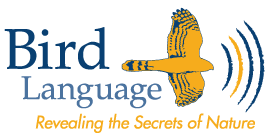Welcome to our Free Bird Language E-Course!
Each week, you’ll receive an email that brings you to the next part of the course. Each section contains core principles of bird language and exercises that you can apply in the yard or at your favorite sit spot.
This e-course is a great companion to Jon Young’s book, What the Robin Knows, which we highly recommend. Beyond this free course, we’ll also provide further opportunities to deepen your skills, through one of our online trainings or in person workshops.
We hope you enjoy the course and have fun connecting with your local birds!
Josh Lane and the Bird Language Team
What is Bird Language?
by Josh Lane
There is a universal language in nature. Many kinds of birds and animals communicate through this “secret,” yet common, language.
For thousands of years, people around the world in varied, traditional place-based cultures have successfully learned enough of this language to help locate food and stay safe from danger. Scientific research is now beginning to “catch up” with this ancient traditional ecological knowledge.
A number of excellent studies have begun to emerge, documenting a variety of different aspects of animal communication. Much has been discovered, yet each answer opens a doorway to new questions and mysteries.
Examples of Bird Language in Action:
-Black-capped Chickadees are known to use different calls in proximity to different types of predators, varying the degree of endings on their “chick-a-dee-dee-dee” call based on the danger level of the predator.
Nuthatches have been found to listen in on the chickadee vocalizations to help assess the threat level of different raptors at a distance. University of Washington (2007, March 19). Eavesdropping Nuthatches Appear To Understand Chickadees In Distress.
-Jim Corbett, the famous conservationist and tracker from the Kumaon foothills of India, wrote in his book, Jungle Lore, that he always knew where the leopard was by the sounds of the other animals in the forest.
-A study published in 2008 showed that Siberian Jays use different calls to indicate the threat level of hawks. A perched hawk elicited a different jay call than a hawk actively searching for prey, and direct hawk attack elicited its own type of call.
Other jays responded to the attack call by fleeing to a safer place and then looking for the hawk; the searching hawk call led jays to hide and remain still; and the perched hawk call alerted other jays to fly up to a higher level and then look for the hawk.
(Uppsala University. “Some Birds Can Communicate About Behavior Of Predators.” ScienceDaily, 9 Jan. 2008. Web. 2 Feb. 2012.)
What is this universal language? How can you learn it?
The building blocks of this communication system are simple enough:
1) sound
2) motion
3) the nature of the intent behind the behavior
Sound & Motion
A bird’s posture and vocalization patterns contain a lot of information. By getting to know and understand some basic patterns, we can learn to understand a lot about what is happening in that moment in time not just for that bird, but for other birds and animals in the area.
An American robin that is on a perch, singing persistently it’s “cheeri-up-CHEERIO-cheerily” song and scanning in multiple directions is carrying a different intention and presence than a robin that is perched but looking alertly in one direction, pumping its tail and uttering a sharp “TEET-tut-tut-tut!” call.
Listen:
Baseline vs Alarm
This could be the same bird, on the same perch, but the quality of the calls and postures exudes a totally different feeling.
The first scenario, with the singing bird, denotes what we call the “baseline” state for that bird: the bird is not in immediate danger, and is able to sing, proclaim and defend his territory, and (hopefully) attract a mate.
The robin in the second example has been forced to leave that state of baseline. Something has caused enough concern for the bird to utter an alarm call. The robin peers into the distance, giving both visual signals through tail flicking, and auditory signals through the vocalized notes. What is causing the alarm?
This is where the journey into understanding bird language begins.
Many other birds and animals will take notice of the robin’s altered behavior. Birds in the distance may pause their feeding or songs to take notice. Other birds may begin to alarm as well. Some types of alarm even occur through an animal’s LACK of sound and motion.
The skill, challenge, and great fun of bird language is in learning to interpret who is causing the alarm, and how the ripple of disturbance is moving across the landscape.
We’ll get further into this art of interpretation later. For now, go outside and observe some of the birds in your area. We recommend starting with getting to know one common bird in your area. The American robin (Turdus migratorius) is a great one to start with because they are so common and widespread. We’ll recommend others as we move further along.
Adventure of the Week:
For now, just get outside and try to find one bird that is common around your home. Even if you think you know this bird well, make some observations and deepen your connection with this species. If you don’t know the bird species by name, try to sketch it or get a photo, and look it up in a field guide.
If you are familiar with the species, try to learn something new about the behavior being exhibited.
Getting started:
–Use all of your senses while in the field. Take your time and slow down. Let go of the fast pace of daily life and enjoy each moment. Walk softly and slowly.
–Make sure you are comfortable while observing in the field; dress appropriately for the weather. Your body temperature may drop if you sit still for a while.
–Find a nice place to sit, with a good view of the area where you can settle in. Be calm and still in order to minimize disturbance to the area. Sit for half an hour or forty minutes if possible; if not, even five minutes can help you connect and de-stress.
–Let your body language be relaxed and natural. Don’t make any fast, startling motions if you see a bird or mammal.
–Use your peripheral vision to help spot movements of birds and other animals, then focus in when needed to catch the details. In general, keep your eyes ahead and softly looking into the distance to scan for bird activity.
–Bring a small pocket notepad with you to jot down any observations or sketches. Write down any questions or thoughts you want to follow-up on later.
Do This:
Make this moment of connection a daily habit, even if it is only for five minutes. Keep a journal of your field notes, with the date, basic weather pattern (breezy? Calm? overcast? raining? temperature?), and notes on the birds you observed (little brown birds in a flock perched on a wire).
We’ll be asking you in Part 2 next week about your observations, so make sure you get out there. It’s okay if you don’t know the names of the birds you see as you are starting out. Just do your best to describe them, and we will give you tips on identification next time.
Bird language is about learning tendencies and patterns of behavior, so you can learn a lot just by observing what a bird or group of birds is doing (or not doing).
Have fun!
About the Author
 Josh Lane is a lead mentor with the 8 Shields Institute. Having been immersed in deep nature connection mentoring for over 15 years, Josh enjoys sharing the ancient arts of bird language and wildlife tracking skills.
Josh Lane is a lead mentor with the 8 Shields Institute. Having been immersed in deep nature connection mentoring for over 15 years, Josh enjoys sharing the ancient arts of bird language and wildlife tracking skills.
Josh is also a musician and is found regularly playing the mandolin at local barn dances; he lives in the Santa Cruz Mountains in California.
